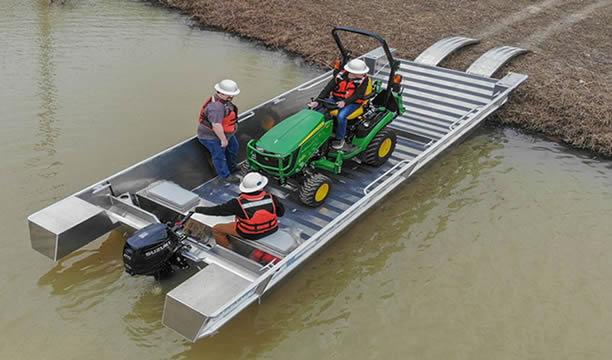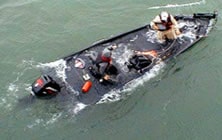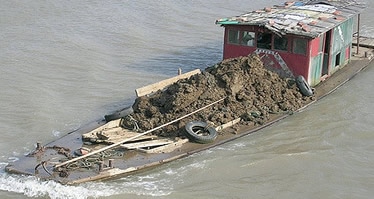In this article we look at the weight capacities of flat bottom boats with many examples given of popular brand name Jon boats.
Contents
WEIGHT CAPACITIES OF FLAT BOTTOM BOATS
Flat bottom boats have shallow drafts and most have low freeboards. This means they sit fairly low in the water with the boat’s waterline sometimes being only inches from the water surface.
Obviously then if such a boat were to be overloaded it would be susceptible to sinking.
So, how much weight can a flat bottom boat hold?
The weight capacity of a flat bottom boat largely depends on the boat type and its size.
Manufacturers will include passenger and weight capacity on the boat or in the owner’s manual.
Alternatively you can use a simple formula to calculate both.
How much weight a flat bottom boat can hold depends on several factors
The weight capacity of any boat can be determined through the formulas included in this article.

We have also included a selection of weight capacities for common Jon boats below.
However, it is always better to follow the recommendations that the manufacturer has outlined for your particular boat.
There is usually a plaque of some sort attached to your boat that will give you both the passenger capacity and the weight capacity of the vessel.
Some boats will just have a number at the side of the transom which indicates the weight capacity.
If the plaque or number is not visible or is missing then refer to the owner’s manual of the boat.
If you can’t get hold of an owner’s manual do an Internet search for your particular make and model.
If you still cannot find the information you are seeking then use the formulas outlined below but be aware that they only give estimates.
Because they are estimates we strongly advise you to get the accurate information from the sources previously mentioned, if at all possible.
The dangers of exceeding a flat bottom boat’s weight capacity
Apart from breaking regulations, and possibly some laws, there are obvious dangers associated with overloading a boat.
 Pushing a boat past its weight capacity is asking for trouble.
Pushing a boat past its weight capacity is asking for trouble.
Once an overloaded flat bottom boat starts to take on water the result is usually a sunken boat.
Apart from the obvious risk to the people onboard you also run the risk of losing expensive equipment and your boat, if the vessel starts to take on water and eventually sinks.
Excess weight on the boat and instability go hand-in-hand on a flat bottom boat
A flat bottom boat, like a Jon boat for example, tends to sit lower in the water and the sides will be closer to the waterline than boats with other hull designs.
The flat bottom hull makes a Jon boat, and all flat bottom boats, very stable in calm water but if the wind picks up, and choppy waves begin to form, a flat bottom boat can become unstable.
The combination of instability and sitting close to the water surface makes it all too easy for a flat bottom boat, such as a Jon boat, to start taking on water.
Imagine, if you will, that you are enjoying a day out on a river or lake fishing in a Jon boat.
A slight change in the weather for the worse is usually not a problem.
A Jon boat can ride the small waves caused by light winds easily, but if the wind gets strong and starts creating troublesome waves it can create stability problems for the boat.
 This is not usually a dangerous situation because at that stage Jon boat owners will either head for dry land or try to deal with the stability issues until the weather either improves or becomes so problematic that they have to leave the water.
This is not usually a dangerous situation because at that stage Jon boat owners will either head for dry land or try to deal with the stability issues until the weather either improves or becomes so problematic that they have to leave the water.
However, even in very slight waves and light winds the situation can become downright hazardous if you are in an overloaded boat.
Let’s say for example, you don’t know the weight restrictions of your flat bottom boat and have inadvertently overloaded it with gear.
When you go on the water the overloaded boat will sit so low to the water’s surface than even the smallest of waves will breach the boat.
If the weather turns for the worse the boat will start to take on water as the waves splash over the sides.
If the weather turns quickly you may not have enough time to get to safety before the boat sinks.
Hopefully the above simplistic illustration lets you can see the importance of knowing the weight capabilities of your flat bottom boat.
TYPICAL JON BOAT WEIGHT CAPACITIES
Below are the weight capacities of 34 popular brand name Jon boats.
I have divided each section by the length of the boat for easier reading
How much weight a Jon boat hold – listed by boat length
The weight capabilities of a Jon boat largely depend on its size. Obviously bigger boats can hold more.
You can read the most important information about using a Jon boat here.
Some modification to the boat, such as PVC side piping which we showed you how to attach in the article how to make a jon boat more stable. Those modifications can help to stabilize the boat in the water but it will also increase its weight capacity.
Below is a quick reference guide to how much a Jon boat can hold based on size, make and construction material
10 foot Jon boat weight capacity (6 examples)
- Alumacraft 10 Foot Jon Boat: weighs 95 pounds with 325 pounds of carrying capacity
- Lowe L1032 Jon: weighs 80 pounds with 275 pounds of carrying capacity
- Waco Jon 1432 Series 10 Foot: weighs 78 pounds with 235 pounds of carrying capacity
- Tracker Topper 1036: weighs 112 pounds with 380 pounds of carrying capacity
- Smoker Craft 1032: weighs 100 pounds with 290 pounds of carrying capacity
- G3 Boats 1036: weighs 100 pounds with 325 pounds of carrying capacity
12 foot Jon boat weight capacity (8 examples)
- Alumacraft 12 Foot Jon Boat: weighs 105 pounds with 455 pounds of carrying capacity
- Lowe L1232: weighs 90 pounds with 389 pounds of carrying capacity
- Waco Jon 1432 Series 12 Foot: weighs 88 pounds with 385 pounds of carrying capacity
- Tracker Topper 1236: weighs 126 pounds with 480 pounds of carrying capacity
- Smoker Craft 1232: weighs 120 pounds with 390 pounds of carrying capacity
- G3 Boats 1236: weighs 144 pounds with 470 pounds of carrying capacity
- Pelican Intruder 12: weighs 127 pounds with 420 pounds of carrying capacity
- Lost Creek 12 Foot: weighs 90 pounds with 389 pounds of carrying capacity
14 foot Jon boat weight capacity (6 examples)
- Waco Jon 1432 Series 14 Foot: weighs 104 pounds with 430 pounds of carrying capacity
- Lowe L1436: weighs 185 pounds with 675 pounds of carrying capacity
- Tracker Topper 1436: weighs 162 pounds with 580 pounds of carrying capacity
- Smoker Craft 1436: weighs 182 pounds with 720 pounds of carrying capacity
- G3 Boats 14 Foot (average of 14 foot models): weighs 190 pounds with 685 pounds of carrying capacity
- Lost Creek 14 Foot: weighs 145 pounds with 552 pounds of carrying capacity
16 foot Jon boat weight capacity (7 examples)
- Alumacraft 16 Foot Jon Boat: weighs 320 pounds with 1,010 pounds of carrying capacity
- Lowe L1648: weighs 275 pounds with 1,014 pounds of carrying capacity
- Tracker Grizzly 1648 Jon: weighs 638 pounds with 1,055 pounds of carrying capacity
- Smoker Craft 1648: weighs 295 pounds with 900 pounds of carrying capacity
- G3 Boats 16 Foot (average of 16 foot models): weighs 375 pounds with 975 pounds of carrying capacity
- Crestliner 1600: weighs 275 pounds with 1,000 pounds of carrying capacity
- XPress Boats 1650 VJ: weighs 341 pounds with 980 pounds of carrying capacity
18 foot Jon boat weight capacity (3 examples)
- Tracker Grizzly 1860 Jon: weighs 794 pounds with 1,550 pounds of carrying capacity
- Crestliner 1800: weighs 475 pounds with 1,375 pounds of carrying capacity
- G3 Boats 16 Foot (average of 18 foot models): weighs 375 pounds with 975 pounds of carrying capacity
20 foot Jon boat weight capacity (4 examples)
- Lowe Roughneck 2070: weighs 710 pounds with 1,900 pounds of carrying capacity
- Crestliner 2070 Retriever: weighs 710 pounds with 1,900 pounds of carrying capacity
- G3 Boats Gator Tough (average of 20 foot models): weighs 1,065 pounds with 1,550 pounds of carrying capacity

How many people you can safely fit in a flat bottom boat
Most small flat bottom boats, such as a Jon boat or small flat-bottomed skiff, are sold with 1 or more benches depending on the size of the boat.
Obviously, the first thing to do when judging how many people can fit in the boat is to determine how many seats the boat has.
This is usually a good indication of how many people the boat can comfortably and safely accommodate.
However, not all humans are created the same. Some people are heavier than others, so be sure to understand the weight capabilities of your particular boat.
As I outlined above, overloading a boat, especially a flat bottom boat that sits close to the water surface, is extremely dangerous and could also be costly financially if you lose all your equipment.
If you intend to have passengers on your Jon boat as well as gear be sure to compare the weight capacity of the boat to the overall combined weight of the crew, passengers and gear.
How to calculate the passenger capacity of your boat
Look for the passenger count and also the weight capacity of your boat.
This will usually be on a plaque somewhere on your boat or in the owner’s manual.
If your boat does not have a plaque, or weight capacity number on the transom and you don’t have access to a manual, try an Internet search.
If all else fails you can determine the passenger capacity yourself using the formula below.
This is a quick method to calculate the passenger and weight capacity of your boat.
Please bear in mind that this is an estimate only as we use an average weight and not everyone weighs the same; a boat filled with college football players would require a much higher average weight number!
First determine the number of passengers your boat is designed to carry as follows:
- Multiply boat length by boat width.
- Divide by 15.
Example:
You have a 15 ft long, 4 ft wide Jon boat.
- 15 x 4 = 450
- 450 / 15 = 4
A quick calculation tells us that the passenger capacity of your Jon boat is 4 people.
However, you now have to determine the weight capacity.
How to calculate the weight capacity of your boat
To determine the weight capacity of your boat use this simple formula:
- Multiple the passenger capacity of your boat by the average weight of your passengers.
Example:
You own a 15 foot Jon boat which can seat 4 passengers. The average weight of a passenger has been historically set at 150lbs (which is slightly outdated in my opinion).
The formula states:
-
- Passenger count x average passenger weight = weight capacity of boat
So this equates to:
-
-
- 4 x 150 = 600lbs
-
Your 15 foot Jon boat therefore has an approximate weight capacity of 600 lbs.
I reiterate the point I made above – this is an estimate and it is much better to get the exact figures from the manufacturer.
How much weight a flat bottom freight boat can hold
There are different types of flat bottom freight boats, as outlined in the article What is a Flat Bottom Boat, but the most common would be the barge.

To calculate how much weight/payload you can put on your flat bottom barge use the following formula:
First determine the volume and weight of your vessel in order to calculate the possible additional load.
Once you know the above values you can easily determine how much payload your vessel can hold.
To calculate maximum payload weight apply the following formula:
Volume * Water Density * Gravity Acceleration * 0.9 = Buoyancy
Buoyancy – Weight (empty Barge) = Payload/weight capacity
The value of 0.9 is added to the formula as a safety factor.
Below are charts outlining how much weight a selection of commercial barges can carry. This information is for general use only.
Barge design, age, current condition, and individual characteristics will determine final barge capabilities.
Deck barges inland river construction weight capacities
[table “lt9gt” not found /]Hopper barges fiberglass lift covers
(Tonnages will vary based on barge construction)
[table “lt10gt” not found /][table “lt13gt” not found /]
Ocean deck barges: approximate S/T capacity and freeboard
[table “lt11gt” not found /]Crane barges weight capacities
Proper crane placement, matting, and safe operation should be the number 1 priority for any crane operation.
[table “lt12gt” not found /]

